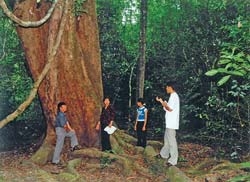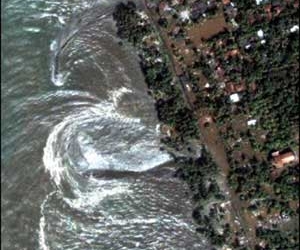The island of Hunga Tonga-Hunga Ha’apai, which emerged and disappeared within 7 years, has brought many fascinating discoveries for scientists.
Hunga Tonga-Hunga Ha’apai is named after the two islands it rose between, starting to form underwater in December 2014 after a submarine volcano erupted and surfaced in January 2015. This resulted in an island with an area of 1.9 km2.

Satellite image of the Tonga eruption. (Photo: Simon Proud).
Scientific Research
According to researchers, Hunga Tonga-Hunga Ha’apai is the third landmass to appear and exist for over a year in the past 150 years.
Scientists were surprised to discover a group of strange bacteria that likely originated from deep below the Earth’s surface. This new finding was published in the journal mBio on January 11.
Nick Dragone, the lead author and a PhD candidate at the Department of Ecology and Evolutionary Biology at the University of Colorado, stated, “We were expecting to find organisms as the glacier receded or cyanobacteria emerging on the island. Instead, we discovered a unique group of bacteria that metabolizes sulfur and gases in the atmosphere.”
To identify the type of bacteria inhabiting the island, researchers collected 32 soil samples from non-vegetated surfaces, starting from deep underwater to 120 meters high at the volcano’s crater before extracting and analyzing the DNA found within.

Volcano eruption caused a tsunami. (Photo: BBC).
However, on January 15, 2022, the Hunga Tonga-Hunga Ha’apai volcano erupted again, exploding with a force estimated to be greater than 100 atomic bombs dropped on Hiroshima, Japan. This eruption ended the scientists’ research on the island. The brief existence of this land provided scientists with an opportunity to study how life develops on new landforms.
Dr. Dragone added, “We all hoped that the island wouldn’t be destroyed. In fact, just a week before the volcano erupted, we had begun planning a return trip for further research. But now the island has disappeared, and when something new forms, we are eager to go there and collect more data.”
Damage
According to Jackie Caplan-Auerbach, a seismologist at Western Washington University, the recent volcanic eruption and all its peculiarities illustrate that humans know very little about submarine volcanoes.
The Hunga Tonga-Hunga Ha’apai volcano has erupted multiple times in the past, but scientists have only recently realized this because most of them are submerged and typically do not cause fatalities. However, this eruption serves as a clear reminder of the risks posed by volcanoes lying just beneath the waves.
Currently, the submarine volcano Hunga Tonga-Hunga Ha’apai seems to be silent. Local residents are helping each other to clear debris and clean up the surroundings. Three confirmed fatalities were residents of Tonga, while two other fatalities occurred in Peru due to the tsunami.

Tsunami caused flooding in several nearby islands. (Photo: BBC).
The damage on several nearby islands was quite severe. All homes of the 36 residents on Mango Island were destroyed. Only two houses remained standing on Fonoifua Island, and widespread damage extended across Nomuka Island, which has a population of 239.
The largest and most populous island, Tongatapu, home to about 75,000 people primarily concentrated in the west, also suffered damage. The Tonga Red Cross estimates that a total of 1,200 households were affected.
Volcanic ash has contaminated the freshwater reserves of the archipelago and delayed the arrival of aircraft carrying additional supplies.
There remains a risk that the volcano could erupt again in the future. Tonga’s Geological Service relies on visual and satellite observations to monitor the activity of many volcanoes in the region.
However, with the volcano’s peak now submerged, scientists have lost sight of signs and find it more challenging to understand volcanic activity.
Even when a volcano is not actively erupting, monitoring most submarine volcanoes is a complex task. GPS positioning, typically used to track surface movement when magma shifts underground, is ineffective underwater. Moreover, collecting real-time data from seismometers on the ocean floor is a challenging and costly technology.





















































